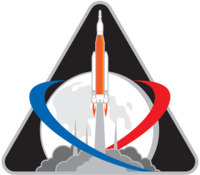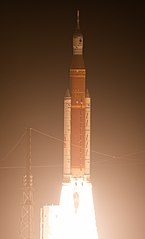Artemis 1
 | |
| Dane misji | |
| Zaangażowani | |
|---|---|
| Oznaczenie kodowe | EM-1, SLS-1 |
| Pojazd | |
| Statek kosmiczny | |
| Rakieta nośna | Space Launch System Block I[1] |
| Załoga | |
 Start misji Artemis 1 | |
| Załoga | test bezzałogowy |
| Start | |
| Miejsce startu | |
| Początek misji | 16 listopada 2022 |
| Misja księżycowa | |
| Czas na orbicie księżycowej | 6 dni |
| Lądowanie | |
| Miejsce lądowania | |
| Lądowanie | 11 grudnia 2022 |
| Czas trwania misji | 26 dni[3] |
Artemis 1, dawniej nazywana Exploration Mission-1 oraz Space Launch System 1 (SLS-1) – bezzałogowa misja kosmiczna prowadzona przez NASA, drugi lot pojazdu kosmicznego Orion. Podczas tego lotu została po raz pierwszy użyta rakieta Space Launch System w wersji Block I. Misja obejmowała wejście na orbitę wokółksiężycową, gdzie pozostała przez 6 dni[4].
Rakieta SLS Block I składa się z większości komponentów użytych w programie STS oraz w rakietach Delta IV:
- Dwóch 5-segmentowych rakiet pomocniczych na paliwo stałe,
- Członu głównego wyposażonego w cztery silniki RS-25D,
- Członu górnego DCSS, przemianowanego na Interim Cryogenic Propulsion Stage.
Lot ma na celu test w pełni operacyjnego statku Orion, a także test osłony termicznej podczas wchodzenia w atmosferę z prędkością 11 km/s.
W lutym 2017 roku w NASA pojawiła się koncepcja, by w misji EM-1 wzięła udział załoga[5]. Gdyby została podjęta decyzja o zrealizowaniu tej misji jako załogowej, prawdopodobnie wiązałoby się to z jej opóźnieniem oraz być może jej ograniczeniem do niskiej orbity okołoziemskiej. W maju 2017 roku NASA zdecydowała się jednak powrócić do pierwotnej koncepcji misji bezzałogowej[6].
13 marca 2019 roku administrator NASA Jim Bridenstine zeznał w Senacie, że NASA rozważa użycie rakiet komercyjnych zamiast SLS[7].
Rakieta SLS wystartowała 16 listopada 2022 z Centrum Kennedy'ego na Florydzie[8]. Wodowanie kapsuły miało miejsce na Oceanie Spokojnym, na zachód od Kalifornii Dolnej, 11 grudnia 2022[9].
Zobacz też
Przypisy
- ↑ Acronyms to Ascent – SLS managers create development milestone roadmap, NASASpaceflight.com [dostęp 2012-08-13].
- ↑ NASA teams evaluating ISS-built Exploration Platform roadmap. NASASpaceflight.com. [dostęp 2012-08-13].
- ↑ NASA Prepares Rocket, Spacecraft Ahead of Tropical Storm Nicole, Re-targets Launch, NASA, 8 listopada 2022 [dostęp 2022-11-19] (ang.).
- ↑ The Ins and Outs of NASA’s First Launch of SLS and Orion. NASA, 27 listopada 2015. [dostęp 2016-11-17].
- ↑ Chris Bergin, Chris Gebhardt: Investigating the potential of including a crew on the maiden flight of SLS. NASASpaceflight, 2017-02-15. [dostęp 2017-02-16]. (ang.).
- ↑ NASA Affirms Plan for First Mission of SLS, Orion, NASA, 12 maja 2017 [dostęp 2017-06-23] (ang.).
- ↑ Jeff Foust: NASA considering flying Orion on commercial launch vehicles. SpaceNews, 13 marca 2019. [dostęp 2019-03-13].
- ↑ Liftoff! NASA’s Artemis I Mega Rocket Launches Orion to Moon, 16 listopada 2022.
- ↑ Splashdown! NASA’s Orion Returns to Earth After Historic Moon Mission, NASA, 11 grudnia 2012 [dostęp 2022-12-14] (ang.).
Media użyte na tej stronie
The flag of Navassa Island is simply the United States flag. It does not have a "local" flag or "unofficial" flag; it is an uninhabited island. The version with a profile view was based on Flags of the World and as a fictional design has no status warranting a place on any Wiki. It was made up by a random person with no connection to the island, it has never flown on the island, and it has never received any sort of recognition or validation by any authority. The person quoted on that page has no authority to bestow a flag, "unofficial" or otherwise, on the island.
NASA’s Space Launch System rocket carrying the Orion spacecraft launches on the Artemis I flight test, Wednesday, Nov. 16, 2022, from Launch Complex 39B at NASA’s Kennedy Space Center in Florida. NASA’s Artemis I mission is the first integrated flight test of the agency’s deep space explorationsystems: the Orion spacecraft, Space Launch System (SLS) rocket, and ground systems. SLS and Orion launched at 1:47 a.m. EST, from Launch Pad 39B at the Kennedy Space Center.
Completed EM-1 Orion weld structure at Kennedy Space Center for final assembly before EM-1.
NASA's Artemis 1 mission patch
- Artemis 1 lays the foundation for the first crewed flight of SLS and Orion, as well as a regular cadence of missions thereafter near the moon and beyond.
- The Artemis 1 patch features the launch of the SLS at the center of its triangular design. The rocket is depicted lifting off from Complex 39B at NASA's Kennedy Space Center in Florida. The major SLS components are shown in simplified form, including the orange insulation-covered core, two side-mounted five-segment solid rocket boosters and the shuttle-legacy RS-25 engines at the base of the core.
- The Orion spacecraft and its European-built service module are mounted on top of the booster. Atop the Orion is its launch abort system tower.
- At the base of the patch, protruding from the launch plume, are the three spires of the pad's lightning protection system and the gantry tower that is part of the new SLS mobile launcher.
- The scene is set against the backdrop of a nearly full moon. Red and blue vectors, jetting out beyond the border of the emblem, wrap around the white celestial body, symbolizing the Artemis 1 flight trajectory, while also infusing the colors of the U.S. flag to the insignia.
NASA's description:
- The artwork for Artemis I, formerly Exploration Mission-1, showcases the Space Launch System (SLS) rocket carrying the Orion spacecraft and lifting off from Launch Pad 39B at NASA’s Kennedy Space Center in Cape Canaveral, Florida. The triangular shape represents the three main programs that comprise NASA’s Deep Space Exploration Systems: Orion, SLS, and Exploration Ground Systems, and is a classic shape for NASA mission emblems dating back to the shuttle era.
- Several elements within the design carry symbolic meaning for this historic flight. The silver highlight surrounding this patch gives nod to the silver Orion spacecraft, including the European service module that will be voyaging 40,000 miles past the Moon in deep space. The orange rocket and flames represent the firepower of SLS. The setting is historic Launch Pad 39B, represented by the three lightning towers. The red and blue mission trajectories encompassing the white full Moon proudly emphasizes the hard work, tradition, and dedication of this American led-mission while also embracing NASA’s international partnership with ESA (European Space Agency) as both agencies forge a new future in space.
- The Artemis I emblem was designed in collaboration by the creative team working for the Deep Space Exploration Systems programs, which includes Orion, SLS, and Exploration Ground Systems, located at NASA Headquarters in Washington, Glenn Research Center in Cleveland, Johnson Space Center in Houston, Marshall Space Flight Center in Huntsville, Alabama, and Kennedy. Because the maiden mission of SLS and Orion is uncrewed, the program teams had the rare opportunity to conceive the mission identifier. Artemis II, which will fly with crew, will have an insignia designed by NASA’s Astronaut Office with the help of the crew that will fly aboard the most capable deep space system to take flight.






